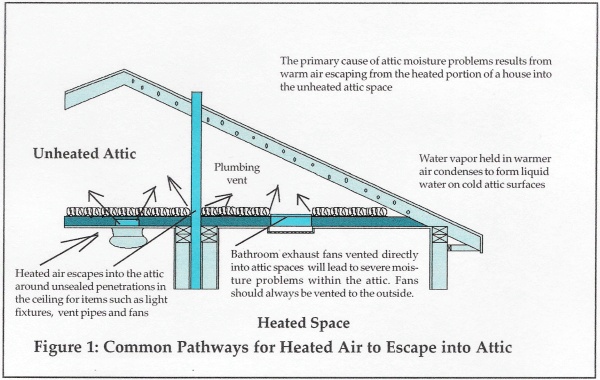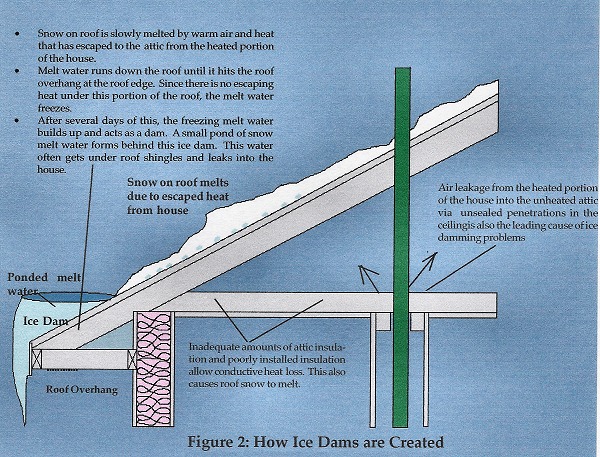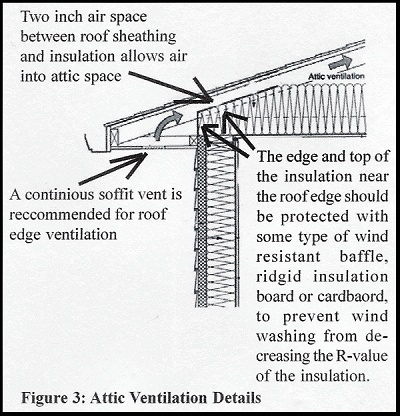
MN License #RR075583 & BC108748









|
|
|||||||||||
Licensed • Bonded • Insured MN License #RR075583 & BC108748 |
 |
 |
 |
 |
 |
 |
 |
 |
 |
||
Information About Attic Condensation and Rood Ice Damming Problems ATTIC CONDENSATION Attic condensation during the winter can decrease the effectiveness of insulation and over time can cause significant damage to structural elements in the attic such as rafters or trusses. And the same factors that cause attic condensation problems also cause ice build-up on roof edges, which can lead to ice damming. If ice damming occurs it often results in snow-melt water entering the home with the potential of causing significant water damage to the home's interior. Attics tend to be very inhospitable places (scorching hot in the summer and freezing cold in the winter) so the average homeowner seldom visits the attic to check its condition. Therefore, if an attic condensation problem does exist, it often goes undetected until significant damage has occurred. As mentioned previously, the same factors that cause attic condensation problems also cause ice build-up on roof edges. So if you have noticed that you have lots of icicles hanging from the edge of your roof, it is also probable that your attic has condensation problems. | |||||||||||||||||
 |
|||||||||||||||||
|
Causes of Attic Condensation Problems The primary cause of attic moisture problems is due to moisture transported from the heated portion of the home into the unheated attic via airflow (see Figure 1 above). This occurs during the winter heating season,. While moisture contained in the escaping house air is responsible for the condensation problems, the heat contained in the escaping air is the primary cause of the ice damming problem. The escaping warm air raises the temperature of the attic above 32 degrees causing any snow on the roof to melt and run down to the colder roof edge where it freezes and turns to ice. Improper installation of attic insulation also contributes to ice damming problems (see figure 2 below). The first step in managing attic moisture problems is to manage moisture within the living area of your home. Managing moisture levels can be divided into two basic areas: Reducing excess sources of moisture and ventilation in high moisture areas. |
|||||||||||||||||
 |
|||||||||||||||||
Reducing Excess Sources of Moisture This involves reducing moisture sources in the home and avoiding activities that can generate very high levels of moisture (See Table 1 for the amount of excessive moisture produced by these activities). Avoid or address the factors listed below to keep moisture generation levels during the winter within manageable levels. | |||||||||||||||||
|
|
|
||||||||||||||||
Ventilation in High Moisture Areas Significant amounts of moisture are generated during the process of living in and using our homes. Everyday activities such as bathing, cooking, and doing laundry produce moisture in the form of water vapor. The amount of water vapor produced by these activities typically does not have a negative impact on the building or its occupants if this moisture is quickly vented to the outdoors by an exhaust fan. If you do not have exhaust fans in bathroom and kitchen areas, consider having them installed. If that is not possible, then open a window slightly during periods of high moisture generation to allow excess water vapor to escape. If you already have exhaust fans, pay attention to the following issues to make certain the fans are doing an effective job of ventilation: | |||||||||||||||||
Determining if Your Attic has a Condensation Problem If you have significant ice build-up on roof edges during winter, you can assume that your attic has condensation problems. You can climb into the attic and inspect for signs of condensation. If you do so during the winter, you may actually observe condensation or frost. Look at the underside of the roof boards for water droplets, or if it's below freezing look for signs of frost. Water and frost are often most visible on the ends of roofing nails that have penetrated plywood roof sheathing or boards. If you check the attic during the summer, look for visible signs that moisture has been present. Water stains resulting from roof leaks will be confined to relatively small areas, while water stains caused by condensation will cover a very large area. In some cases, water may actually leak through the ceiling when temperatures in the attic rise rapidly above freezing after a long cold spell which melts the frost that has formed in the attic. Mold growth covering a large area on the underside of the roof sheathing also indicates that attic condensation is a problem. | |||||||||||||||||
|
Fixing Attic Condensation & Roof Ice Problems To fix attic moisture and ice damming problems, three factors need to be addressed: 1.) Prevent warm air in living spaces from infiltrating into the attic with a good air barrier between the heated portion of the house and the attic. Properly finished drywall or plaster on ceilings provide an adequate air barrier. But singificant air leakage occurs wherever there are penetrations in plaster or drywall ceilings. Most insulation products are not effective air barriers, so even well insulated attics can have significant air leakage problems. Plumbing vent pipes, chimneys, recessed lights, and attic access stairs are examples of penetrations that need to be carefully air-sealed. The typical homeowner does not have the expertise, equipment or experience to adequately do this job. Therefore, it is advisable to seek the services of a professional to find and seal air leaks. 2.) Prevent conductive heat loss between living areas of the home and the un-heated attic by making certain that attic insulation levels are adequate and that insulation is correctly installed. The US Department of Energy recommends that ceilings have insulation levels rated at R-49. A 15-inch thick layer of cellulose insulation or a 27-inch thick layer of fiberglass insulation is required to obtain an R-49 insulation level. Few attics are insulated to these recommendations. Doing so can significantly reduce home heating bills. Combining proper levels of insulation with air-sealing will prevent both attic condensation and ice damming problems. | |||||||||||||||||
3.) Provide ventilation on non-heated attic spaces. Even with sufficient insulation levels and a good air seal between the attic and heated spaces below, some heat may escape. Attic ventilation is suggested because it can draw this heat from the attic before it can accumulate and begin to melt roof snow. It also keeps the roof coller in summer. In addition, builiding codes often requiere attic ventilation. Open attics should have 1 square foot of vent area for every 300 square feet of ceiling area. Catherdral ceilings should ahve q square foot of vent area for every 150 square feet of ceiling area. The most effective attic ventilation strategies divide ventilation are equally between soffit (roof edge) and roof peak areas. Correctly installed soffit ventilation allowa air into the attic area, but also protcts insualtion from te negative effects of wind washing (see Figure 3 on the right). More information on attic ventilation can be found here. |
 |
||||||||||||||||
Click HERE to go back to the home page.
| Home Page | Roofing | Siding | Doors & Windows | Carpentry | Construction | Decks & Awnings | Testimonials | Employment | Contact Us |
| © 2013 E. H. Lawrence Company, Inc. | |||||||||